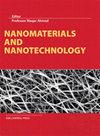Immunosensing the rheumatoid arthritis biomarker through bifunctional aldehyde-amine linkers on an iron oxide nanoparticle seeded voltammetry sensor
IF 3.3
3区 材料科学
Q2 MATERIALS SCIENCE, MULTIDISCIPLINARY
引用次数: 4
Abstract
An immunosensor was developed on an interdigitated electrode (IDE) by voltammetry sensing for the early identification of the autoimmune disease ‘rheumatoid arthritis (RA)’ by detecting the biomarker anti-cyclic citrullinated peptide antibody (anti-CCP). Higher immobilization of cyclic citrullinated peptide (CCP) as a probe was achieved by using green synthesized iron oxide nanoparticles (IONPs). Field-emission scanning electron microscopy and field-emission transmission electron microscopy observations revealed that the polydispersed material displayed multifaceted features. X-ray photoelectron spectroscopy analysis confirms the occurrence of Fe, O, and C groups on the synthesized IONPs. IONPs were immobilized with a probe on IDE through bifunctional aldehyde-amine linkers. Due to the elevated occupancy of CCP and the highly efficient electric transfer from IONPs, higher changes in current are observed upon binding of anti-CCP with CCP. In the linear range from 8 to 250 pg/mL, the sensitivity and detection limit of anti-CCP were 8 and 15 pg/mL, respectively, with a regression coefficient of y = 1E−06x−3E−07; R2 = 0.9637. Control experiments with nonimmune antibody and anti-carcinoembryonic antigen indicate the specific detection of anti-CCP. Furthermore, spiking of anti-CCP in human serum does not interfere, representing the specific detection of anti-CCP. This CCP-immobilized IDE through IONP helps to quantify anti-CCP levels in the biological fluid for diagnosing RA.通过氧化铁纳米粒子种子伏安传感器上的双功能醛胺连接物免疫感应类风湿性关节炎生物标志物
采用伏安感应技术,在交叉指状电极(IDE)上开发了一种免疫传感器,通过检测抗环瓜氨酸肽抗体(anti-CCP)的生物标志物,用于自身免疫性疾病类风湿关节炎(RA)的早期识别。利用绿色合成的氧化铁纳米颗粒(IONPs)实现了环瓜氨酸肽(CCP)探针的高固定化。场发射扫描电镜和场发射透射电镜观察表明,多分散材料具有多面性。x射线光电子能谱分析证实在合成的离子上存在Fe、O和C基团。通过双功能醛-胺连接剂,用探针在IDE上固定离子离子。由于CCP的占用率升高以及IONPs的高效电转移,当anti-CCP与CCP结合时,观察到电流的较大变化。在8 ~ 250 pg/mL的线性范围内,抗ccp的灵敏度和检出限分别为8和15 pg/mL,回归系数为y = 1E−06x−3E−07;R2 = 0.9637。非免疫抗体和抗癌胚胎抗原对照实验表明抗ccp特异性检测。此外,人血清中抗ccp的尖峰不受干扰,代表了抗ccp的特异性检测。这种通过IONP固定ccp的IDE有助于量化生物液中的抗ccp水平,用于诊断RA。
本文章由计算机程序翻译,如有差异,请以英文原文为准。
求助全文
约1分钟内获得全文
求助全文
来源期刊

Nanomaterials and Nanotechnology
NANOSCIENCE & NANOTECHNOLOGY-MATERIALS SCIENCE, MULTIDISCIPLINARY
CiteScore
7.20
自引率
21.60%
发文量
13
审稿时长
15 weeks
期刊介绍:
Nanomaterials and Nanotechnology is a JCR ranked, peer-reviewed open access journal addressed to a cross-disciplinary readership including scientists, researchers and professionals in both academia and industry with an interest in nanoscience and nanotechnology. The scope comprises (but is not limited to) the fundamental aspects and applications of nanoscience and nanotechnology
 求助内容:
求助内容: 应助结果提醒方式:
应助结果提醒方式:


